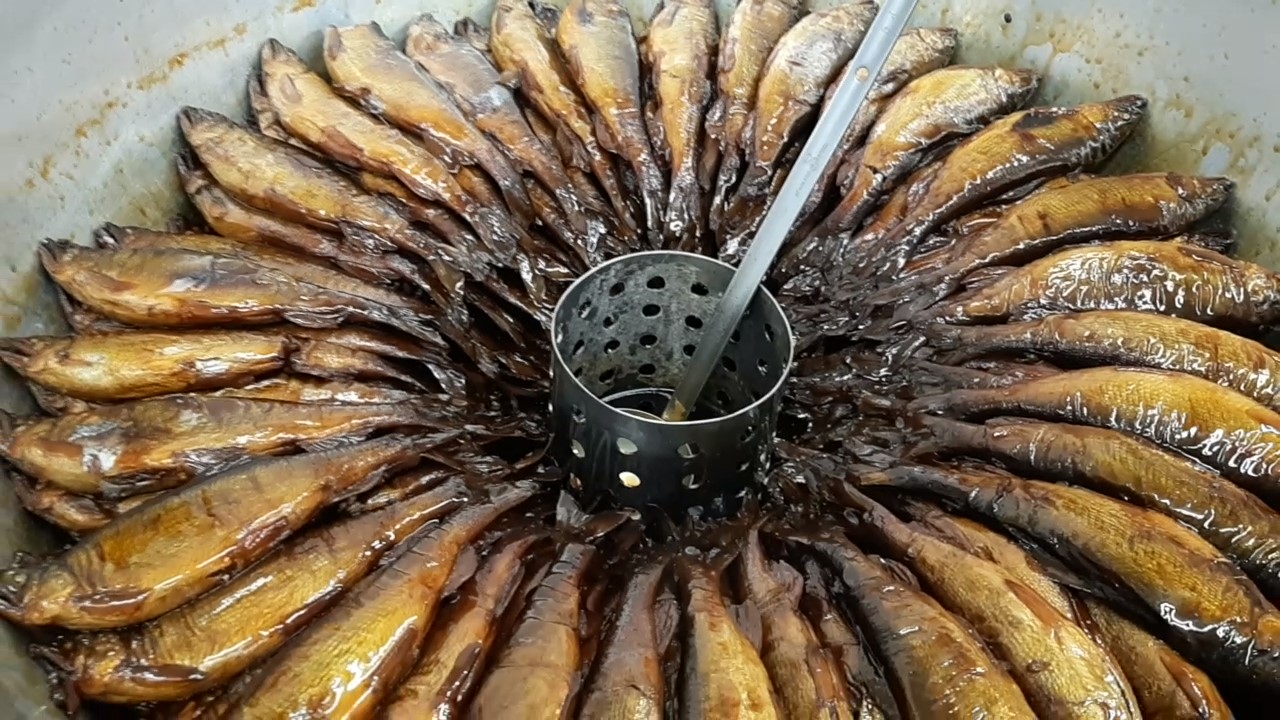
いつもありがとうございます。
今回は「子持ち鮎の甘露煮」の作り方を
解説いたします。
この作り方は小鮒やワカサギ、ゴリなどにも
応用できるので是非習得して下さい。
この記事の最後に同じ内容の動画を貼り付けてあるので
あわせてご覧になると分かりやすと思います。
子持ち鮎を水洗いする Rinsing Ayu with Roe

鮎の表面のヌメリを水洗いします。 Rinsing the Sliminess from the Surface of Ayu
肛門に糞が残っている場合があるので注意しましょう。
Be cautious as there may be remnants of feces in the anal region.
子持ち鮎を白焼きする Grilled sweetfish with roe
串打ちをするskewer

串はカマのアタリに打ちます。

頭に打つと頭が取れる事があるのでカマを目掛けて打ちましょう。

尾っぽの方にも打ちます。
串が細い場合は同じ場所に二本打つと安定します。

焼き台にのせて白焼きします。

表面が白くなったら裏返して両面がキツネ色になるまで焼きます。
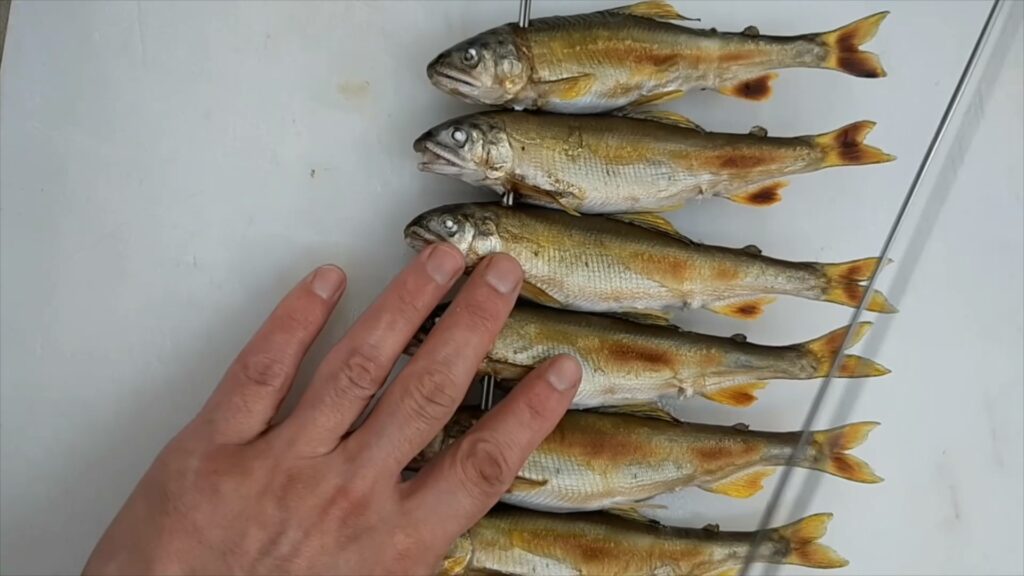
キツネ色に焼き色がついたら串を抜きます。
子持ち鮎をもどす(湯がく)Boil sweetfish with roe
鮎を鍋にきめるArrange the sweetfish with roe in the pot

鍋底にササラをばらしたものを敷き詰めて中央にエントツを立てます。
Place a layer of thinly sliced bamboo shoots on the bottom of the pot, and stand a cylindrical steamer in the center.
このエントツは業者さんに特注で作ってもらいました。
I had this cylindrical steamer custom-made by a professional.
ステンレス製の筒の側面に穴をあけてあります。
There are holes drilled on the side of the stainless steel cylinder.

白焼きした子持ち鮎を放射状に並べます。
Arrange the grilled ayu with roe in a radial pattern.
背よりも腹の方が弱いので腹が上を向くように斜めに並べます
Arrange belly side up
二段目も腹が上を向くように斜めに放射状に並べます。
Arrange the second row in the same way.

三段目は鮎を横に向けて並べても大丈夫です。
Arrange the sweetfish horizontally on the third row.

四段目も横向けに並べます。
The same goes for the fourth row.

五段目は全体が平になる様に低くなっている箇所に鮎をおきます。
カメラの映り方で画面右上が低く見えますが、実際には平になっています。
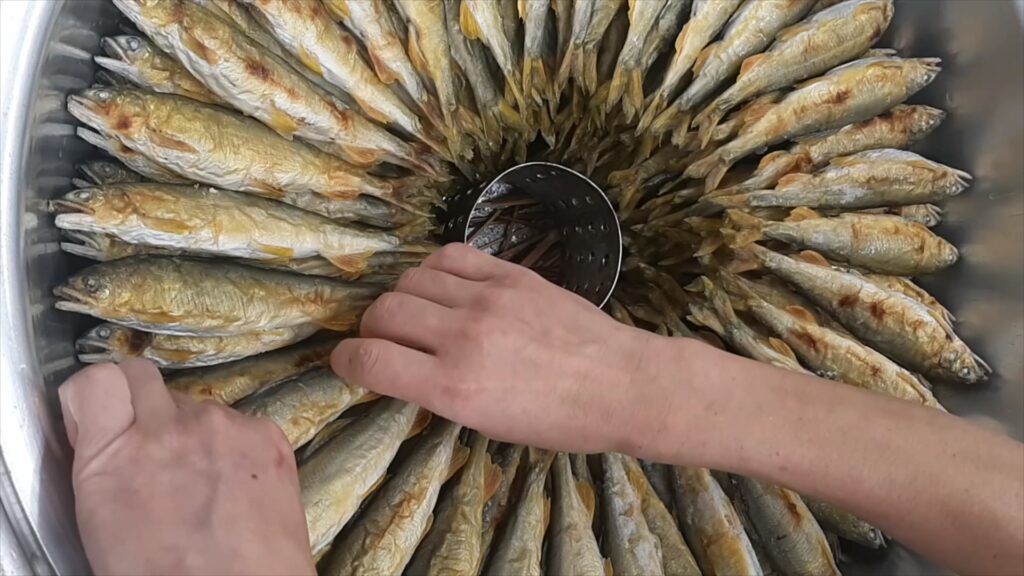
鮎を並べたらへぎ板をのせます。
I’ll put Kyogi on it.
Kyogi is a thin piece of wood.

へぎ板をのせたら落とし蓋をします。
Place the drop lid after setting the partition board.

落としフタをのせたらばっ缶をのせます。
Place the tray can after setting the drop lid.

「かぶるくらい」の水を入れる
Add enough water to cover (the ingredients).
落とし蓋がかぶるくらいの水をいれます。
Add enough water to cover the drop lid.
鮎が泳がない様にばっ缶にも水を入れて重石(おもし)にします。
Add water to the tray can as well to weigh it down so the ayu (sweetfish) doesn’t move.
重石に水を入れ過ぎて鮎が潰れないようにしましょう。
Be careful not to overfill the bat-shaped dish with water, as the weight could crush the ayu (sweetfish).

番茶を入れて湯がくと鮎の臭みが消えると云われています。
It is said that boiling ayu (sweetfish) with bancha (coarse green tea) removes its odor.
お茶袋などに入れると効率良く作業ができます。
By putting bancha (coarse green tea) in a tea bag, the process can be done more efficiently.

酢を入れて湯がくと鮎の骨まで柔らかくなります。
Boiling with vinegar softens the bones of the ayu (sweetfish).
今回200本の鮎に2合の酢を入れました。
“I added two gō (about 360 ml) of vinegar for 200 ayu (sweetfish).

酢が入ったら火にかけます。
After adding the vinegar, put it on the heat.
火力は強火です。
The heat should be set to high.

ポコリポコリと沸いてきたら火を弱めて
Once it comes to a boil, lower the heat.
90℃以上をキープして6時間ほど湯がきます。
Maintain a temperature of over 90°C and boil for about 6 hours.

蒸発した分はお湯をたして「かぶるくらい」をキープします。
Add water to compensate for the evaporation and always keep it at a level where the ingredients are fully submerged.

6時間ほど湯がいたら火を止めて常温になるまで放置です。
After boiling for about 6 hours, turn off the heat and let it sit until it reaches room temperature.
ひとさらしする Rinse briefly with cold water.
常温になったらばっ缶を外してガス台から下し
水でひとさらしします。
Once it has reached room temperature, remove the weighted tray can, take it off the stove, and briefly rinse it with water.


ひとさらししたら穴あきホテルパンなどに丘上げします。
Once it has been briefly rinsed, arrange it in a perforated hotel pan or similar to drain the excess water.


もどした鮎を焚くSimmer the arboiled ayu(sweetfish).
再度、鍋にきめる Arrange them again in the pot.
再び、鍋にササラをばらしものを敷き詰めエントツをたてて鮎をきめます。
Once again, spread scattered pieces of sasara (a type of cleaning brush made from bamboo) on the bottom of the pot, stand a stainless steel tube upright, and arrange the ayu (sweetfish) around it.
鮎の並べ方はさきほどと同じです。
The way to arrange the ayu (sweetfish) is the same as before.






腹の壊れているものや頭の取れているものは
焚き具合をチェックするサンプルとして一番上にきめます。
Place the ones with damaged bellies or missing heads on top as samples to check the cooking progress.

鮎を並べたらへぎ板をのせて、落とし蓋をします。
Once the ayu (sweetfish) are arranged, place a hegi-ita (wooden board) on top, and then put an otoshibuta (drop lid) over it.


「ひたひた」の酒と「かぶるくらい」の水を入れる Add enough sake and water to just cover the fish.
落とし蓋をしたまま酒を「ひたひた」に入れいます。
With the drop lid still in place, add enough sake to just submerge the contents.
「ひたひた」と「かぶるくらい」https://isobemaruyama.com/171/

「ひたひた」の状態はこんな感じです。落とし蓋をはずして見ると・・
The hita-hita (just submerged) state looks like this. When you remove the drop lid…


落とし蓋の上にばっ缶をのせて重石にします。
Place a tray can on top of the drop lid as a substitute for a weight.
落とし蓋がかぶる位の水をいれます。
Add enough water to cover the drop lid.
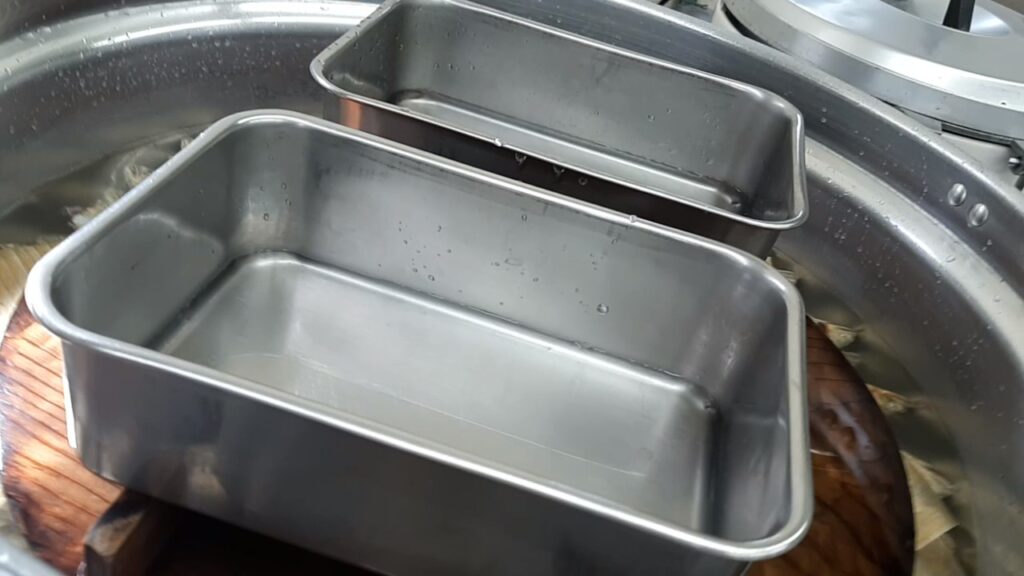

かぶるくらいの水を入れたら火にかけます。火力は強火です。
Once you’ve added enough water to cover it, place it on the heat. Use high heat.

甘焚きをする Add sugar and simmer.
地が沸いてきたら甘焚きをします。
Add sugar once the sake and water start boiling, and simmer.
「ひたひた」の酒を10とした時に濃口醤油1:砂糖2.5(体積比)の量を
用意しておきます。
Prepare an amount of dark soy sauce and sugar in a volume ratio of 1:2.5, based on the sake, with the sake being 10 parts.

地は常に90℃位をキープしながら砂糖を数回に分けてうっていきます。
Keep the temperature of the sake and water around 90°C at all times, while gradually adding the sugar in several portions.
甘焚きを始めてからすぐに濃口醬油の1割ほどの量をうちます。
As soon as you start simmering after adding the sugar, add about 10% of the measured amount of dark soy sauce.
これをしておくと煮崩れしにくくなります。(入れ過ぎると締まって硬くなるので注意)If you add a little dark soy sauce when you start simmering, it helps prevent the ingredients from falling apart.(At that time, be careful not to add too much soy sauce, as it can make the sweetfish (ayu) tough.)

甘焚きは6時間ほどかけるので1時間おきに砂糖をうっていきます。
When simmering with sugar, add sugar every hour and simmer for about 6 hours.
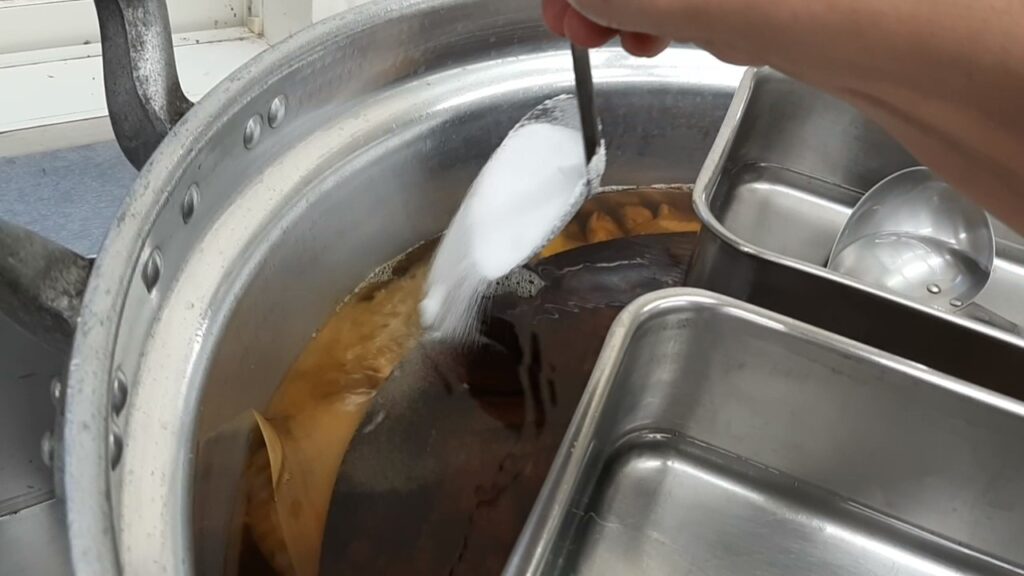
蒸発した分はお湯をたして常に「かぶるくらい」をキープします。
If the water level drops due to evaporation, add hot water to keep the ingredients just submerged at all times.


6時間甘焚きをしたら火を止めて一晩放置してじっくりと甘を含ませます。
After simmering with sugar for 6 hours, turn off the heat. Let it sit overnight to allow the sweetness to thoroughly soak into the sweetfish (ayu).
濃口醤油をうつ Add dark soy sauce.
翌日。
ばっ缶を外して火にかけます。(火力は強火です)
The next day, remove the weighted baking tray or can and put it on the heat.

地が沸いてきたら落とし蓋を外して濃口醬油をうっていきます。
When the sake and water come to a boil, remove the drop lid and add dark soy sauce.

濃口醬油は一度に入れても味には支障はありませんが、
There’s no problem adding the dark soy sauce all at once, but if the water level rises suddenly, the ayu (sweetfish) might start moving.
急激に地の量が増えると鮎が泳ぎ出すので数回に分けて入れた方が良いです。
It’s better to add the dark soy sauce in several stages.
火力も鮎が泳ぎ出さない程度に強火から中火で調整します。
Adjust the heat from high to medium so that the ayu (sweetfish) do not move.
青実山椒もこのタイミングでいれます。
Add green sansho pepper as well.
青実山椒の保存の仕方https://isobemaruyama.com/679/

中央のエントツの上にもへぎ板をのせて地が対流するようにします。
Place a wooden slat over the central cylindrical stainless steel part as well, to allow the liquid to circulate.

鮎が泳ぎ出さない程度に様子を見ながら濃口醤油をうちます。

地を詰め上げる
計量した濃口醬油をうち終えたら更に詰め上げていきます。

火力は鮎が踊り出さない程度に強火です。

濃口醬油が地全体になじんだら、アタリをみて甘と辛のバランスを確認します。

かなり地が詰まってきました。
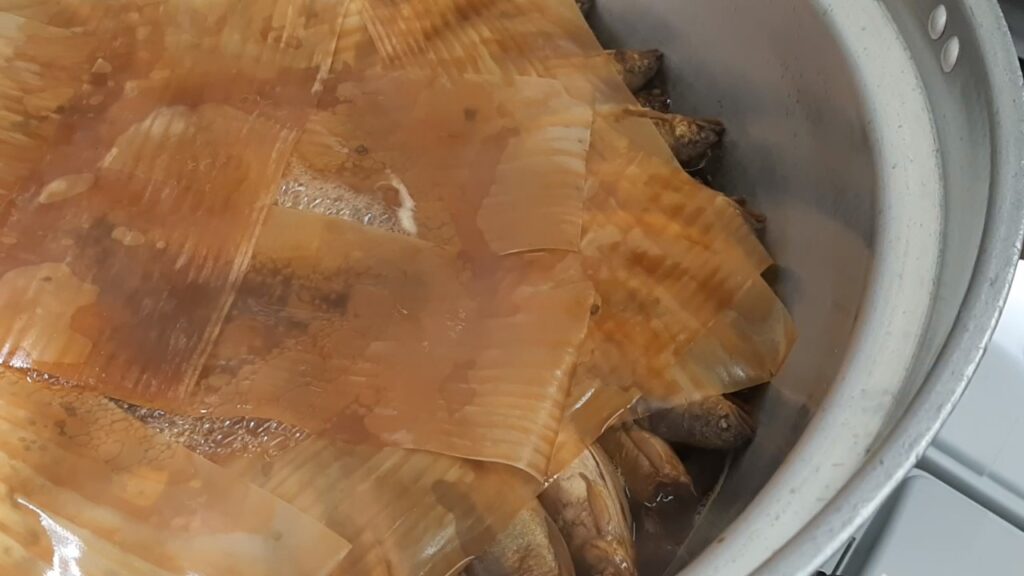
これ位に地が詰まってきたらへぎ板を外しても大丈夫です。
時々、地を回しかけてやります。

ここでアタリをみます。

更に地が詰まってきました。

ここで最後の甘辛チェックです。
甘が強かったので濃口醬油で微調整しました。


地がこれくらいになったら火は中央だけを使います。
外側の火を使うと鍋肌が焦げるので注意しましょう。

地を回しかけながら詰め上げます。

地の詰まり具合を金ハイから垂らしてチェックします。
ワタクシはこの地の垂れ具合で出来上がりを判断しています。

完成したら火を止めます。
常温になるまで時々、地を回しかけてやります。


今回ご紹介した「子持ち鮎の甘露煮」の作り方は
ワタクシが実際にやっているやり方です。
甘露煮の作り方は料理人の数だけやり方があるので
皆さんがやり易い作り方を見つけて習得してください。
それでは、最後まで記事を読んで頂きありがとうございました。
これからも料理道に精進いたします。
by料理長
「子持ち鮎の甘露煮作り方動画」https://www.youtube.com/watch?v=RRcxHxHyHkU
